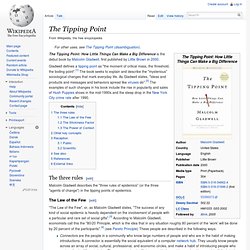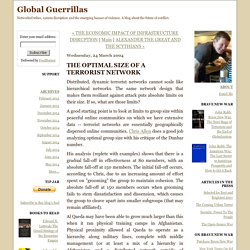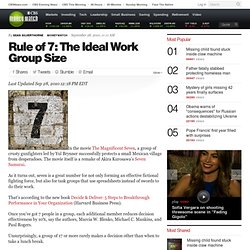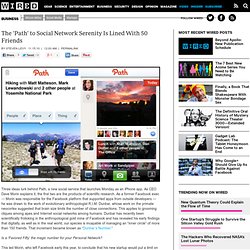

Validation of Dunbar's Number in Twitter Conversations. How Many Friends Does One Person Need?: Amazon.de: Robin Dunbar: Englische Bücher. What is the Monkeysphere? "There's that word again...

" The Monkeysphere is the group of people who each of us, using our monkeyish brains, are able to conceptualize as people. If the monkey scientists are monkey right, it's physically impossible for this to be a number much larger than 150. The Tipping Point. The Tipping Point: How Little Things Can Make a Big Difference is the debut book by Malcolm Gladwell, first published by Little Brown in 2000.

The three rules[edit]
Christopher Allen. THE OPTIMAL SIZE OF A TERRORIST NETWORK. Distributed, dynamic terrorist networks cannot scale like hierarchical networks.

The same network design that makes them resiliant against attack puts absolute limits on their size. Dunbar. Security, Group Size, and the Human Brain. Rule of 7: The Ideal Work Group Size. Last Updated Sep 28, 2010 12:18 PM EDT In the movie The Magnificent Seven, a group of crusty gunfighters led by Yul Brynner successfully protects a small Mexican village from desperadoes.

The movie itself is a remake of Akira Kurosawa's Seven Samurai. As it turns out, seven is a great number for not only forming an effective fictional fighting force, but also for task groups that use spreadsheets instead of swords to do their work. That's according to the new book Decide & Deliver: 5 Steps to Breakthrough Performance in Your Organization (Harvard Business Press). Once you've got 7 people in a group, each additional member reduces decision effectiveness by 10%, say the authors, Marcia W. Nexus: Small Worlds and the Groundbreaking Science of Networks (9780393041538): Mark Buchanan.
Research Intelligence - Issue No 17 - The ultimate brain teaser. Relative to their body size, monkeys, apes and humans have unusually big brains.

It has been suggested that this reflects the complexity of their social lives. This hypothesis is gaining support thanks to ground-breaking research by a University of Liverpool scientist, whose methods have been taken up by primate researchers around the world. These same methods could soon shed light on the story of human evolution. Judged by our genomes, there's surprisingly little difference between humans and chimps: 95% of our DNA is similar, making chimps our closest ape 'cousins'. Judged by most other measures, there are significant distinctions between the two species. Clearly, brain size plays a crucial role: all primates have big brains relative to their body size, but human brains are disproportionately large. Why did these changes take place in primates in general, and humans so particularly?
Innovative Models Significant correlations. The ‘Path’ to Social Network Serenity Is Lined With 50 Friends. Three ideas lurk behind Path, a new social service that launches Monday as an iPhone app.

As CEO Dave Morin explains it, the first two are the products of scientific research. As a former Facebook exec — Morin was responsible for the Facebook platform that supported apps from outside developers — he was drawn to the work of evolutionary anthropologist R.I.M. Dunbar, whose work on the primate neocortex suggested that brain size limits the number of close connections. This applies to grooming cliques among apes and Internet social networks among humans. Dunbar has recently been scientifically frolicking in the anthropological gold mine of Facebook and has revealed his early findings that digitally, as well as in the real world, our species is incapable of managing an “inner circle” of more than 150 friends. Is a ‘Favored Fifty’ the magic number for your Personal Network?
This leads to the third idea behind Path. Communities of practice and Dunbar's number. Posted at 17:01 in . Dunbar is an anthropologist at the University College of London who hypothesized that there is a cognitive limit to the number of individuals with whom any one person can maintain stable relationships, and predicted that 150 is the "mean group size" for humans. Ross Mayfield wrote a very interesting post last year starting from there on Ecosystem of Networks and came out with this nice summarized graph, which I have been struggling a little with to be honest since I saw it for the first time (are axes consistent from one raph to the other?..) Robin Dunbar: How Many Friends Does One Person Need? Bio Robin Dunbar Robin Ian MacDonald Dunbar is a British anthropologist and evolutionary biologist, specializing in primate behavior.
If you’re working in a big group, you’re fighting human nature. When you’ve got a small group, you don’t need to constantly formalize things.

You communicate and you know what’s going on. If you have a question about something, you ask someone. Formalized rules, deadlines, and documents start to seem silly. Everyone’s already on the same page anyway. Ten-groups According to British author Antony Jay, there are centuries of evidence to support the idea that small groups are the most efficient. He offers up interesting examples to back up the theory, from sports teams to juries to army squads: Jay draws attention to units of around this size in many fields beyond the corporation. Groups this size succeed because they have mutual dependence and a common objective:
Leading Leaders - Identity Based Leadership. Dunbar's number.